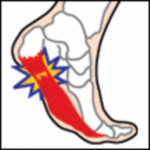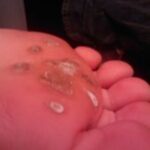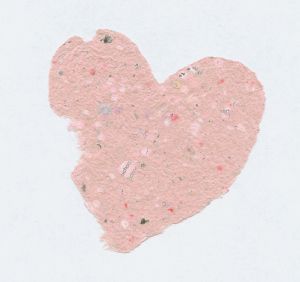As a soon to be, 40-year-old, former high school and collegiate athlete (who still can’t give up the sports), I have certainly had more than my fair share of sports-related injuries.
On one occasion, nearly seven years ago, I awoke one morning after a routine session of basketball the evening before. As I got out of bed, I literally crumpled to the floor in pain the instant my left foot touched the surface of the floor.
As I gathered myself up off of the floor, (while wondering what the hell was going on) I took some of the weight off of my foot by leaning on my bedroom dresser. Once again, I took another step – and although I didn’t hit the deck this time – the pain in my left foot (and more specifically, my heel) was instantaneous and severe.
After trying to “tough it out” for a couple of hours, with no success, I acquiesced to my wife’s demands and made a trip to see my orthopedic surgeon (the same one who repaired my broken fibula a few years earlier).
At any rate, after two minutes of explaining exactly what symptoms I was experiencing, he immediately told me that I had plantar fasciitis. After explaining to me exactly what plantar fasciitis was, he advised me of the different remedies for the illness and added that if the case was severe, it could be treated with a series of Cortisone shots. He then proceeded to spray my feet with a local anesthesia, and then injected my left heel with the anti-inflammatory.
That was nearly seven years ago – and although I am still as active as ever – I haven’t had any problem with plantar fasciitis since then. However, as the saying goes, nothing lasts forever. Three weeks ago, I began to have minor pain again – this time, in both arches and heels and am now in full-fledged agony once again (mainly, in my left heel) which is the reason I sat down to write this column in the first place. Maybe my painful experience can help some poor souls through out there to deal with the nagging illness themselves.
So, let’s learn all about plantar fasciitis and how to deal with it.
Pronounced as “plantar fash-ee-eye-tis,” plantar means “foot,” while fasciitis means “inflammation.” Plantar Fasciitis is a serious, painful and progressing illness that occurs when the long, flat ligament along the bottom of the foot develops either tears or inflammation. Serious cases of plantar fasciitis can possibly lead to ruptures of the ligament itself. This ligament is called the plantar fascia and it extends the toes and runs along the bottom of the foot, attaching to your heel. When you walk or run, you land on your heel and raise yourself on your toes as you shift your weight to your other foot, causing all your weight to be held up by your plantar fascia. Such repetitive force can pull the fascia from its attachment on your heel and cause damage and plantar fasciitis.
Many factors can cause plantar fasciitis to develop. When walking with a normal step, the plantar fascia ligament stretches as the foot strikes the ground. When walking with an abnormal step, or when putting repetitive pressure on the heel, the plantar fascia ligament can stretch irregularly, become stressed, and develop small tears. These small tears can cause the fascia ligament to become inflamed (plantar fasciitis) and also lead to serious pain.
The pain from plantar fasciitis is described as being dull, aching or sharp (all three for me) and can usually be reproduced by flexing the toes upwards and tensing the fascia. Plantar fasciitis also tends to worsen after standing or exercising for prolonged periods or after getting out of bed in the morning. Morning heel pain from plantar fasciitis is one of the most common symptoms and occurs because the fascia becomes tense after a protracted rest. As the person walks, the fascia “warms up” and lengthens slightly, reducing the tension on the ligament and lessening pain.
What Causes Plantar Fasciitis?
The repetitive stress of certain conditions or activities commonly leads to plantar fasciitis. Repetitive pressure on the feet from jobs or activities that require prolonged walking or standing on hard on irregular surfaces – or running and exercise – can also lead to wear and tear on the plantar fascia. Aggravating factors, such as being overweight or having poorly cushioned shoes can also add to the cause of plantar fasciitis. The natural aging process (whoopee for me) may also cause tissue in the heels to weaken over time and/or promote wear and tear. In rare cases, a single, traumatic injury to the foot such as from a motor vehicle accident can cause the onset of plantar fasciitis.
Plantar fasciitis is a common condition, affecting millions of people each year, because the foot must endure significant weight on an almost constant basis. With every step, all of our weight is absorbed by tissue throughout the foot. The heel, in particular, must absorb the brunt of our body’s weight, not to mention any additional pressure from lifting heavy objects or from other activities. Normally, the foot is able to accommodate this weight and allow us to remain on our feet free of pain, but when the foot is loaded to a degree greater than what it can physically tolerate, damage can develop and problems such as plantar fasciitis begin to occur.
Morning Plantar Fasciitis
Morning plantar fasciitis is commonly the most painful type of heel pain associated with this condition. This is because pain from plantar fasciitis is often felt more in the morning. After long periods of rest, such as after waking up in the morning, an inflamed area of the plantar fascia ligament becomes stressed when pressure is put on it. The first steps taken in the morning are usually extremely painful. Terrible morning plantar fasciitis pain results from the plantar fascia ligament being over stretched and becoming inflamed within a few steps. The pain usually subsides over time, however it will return again after long periods of rest, such as over long periods of sitting.
Generally, Plantar fasciitis can present with two types of pain:
Post-rest pain
Post-rest pain occurs after lost periods of rest, such as after waking in the morning, or after prolonged sitting. After prolonged rest, the sharp tearing pain that results usually subsides somewhat after being on the affected foot for about 10 minutes, allowing the fascia to “warm up” and lengthen as a person walks.
Overuse pain
Overuse pain differs from post-rest pain in that it occurs after extended periods of being on the feet, such as after jogging or walking. A dull aching pain on both the bottom and the inside of the heel generally characterizes the pain.
Plantar Fasciitis Treatment methods
While searching for a treatment, many plantar fasciitis sufferers may go to their local drug stores and pick up a simple shoe insert to help relieve pain. As already mentioned, those who suffer from this condition should be wary of products that are not designed to specifically treat plantar fasciitis. Many common shoe inserts available are designed to provide added cushioning to a shoe, and nothing more. Ample cushioning and support in a pair of shoes is necessary to prevent plantar fasciitis, however simple cushioning is not capable of supporting the heel and adding strength to the plantar fascia ligament, which is necessary to reverse tears and inflammation in the tissue.
There are also other plantar fasciitis treatments available other than shoe orthotics. Among them are night splints that are worn during the night and are intended to provide treatment while you sleep. Unfortunately, these braces have many downsides when compared to simple orthotics. First, they are cumbersome and uncomfortable to wear in bed. Secondly, these braces can become very expensive and their questionable results do not make them worth the money.
Other plantar fasciitis treatment methods can include rest and icing the heel. These methods, although are ineffective in actually healing the condition, can reduce some pain and discomfort from the condition. Additionally, there are stretches also available that are easy ways to strengthen the plantar fascia, which will help keep it flexible and prevent further occurrences of plantar fasciitis.
Plantar Fasciitis Exercises are widely used in conjunction with heel seats. These simple plantar fasciitis exercises are to be completed early in the day, some before you get out of bed.
Plantar Fasciitis Exercises
Belt Stretch:
Take a wide belt and hold one end in each hand. Place the center of the belt over the ball of the foot. With your knee straight, pull your ankle back toward you using the belt and the muscle on the front of your leg. Think about reverse stretching your arch. Pull back and hold for ten seconds. Relax and repeat for five to ten minutes.
Massage
Use some type of tubular device placed in the center of the arch. This should be about two inches in diameter and padded. Sitting with your knee bent to ninety degrees begin to gently roll your foot over the massage bar. Increase the pressure until you just begin to feel slight discomfort in the affected area. Maintain that pressure and continue to “roll massage” for 5 to 10 minutes.
Plantar Fasciitis Stretching Exercises
Stretches for plantar fasciitis requires holding onto a countertop or table and squatting down slowly with the knees bent. The heels of both feet must be kept in contact with the floor while squatting. After 10 seconds, straighten up and relax. The stretch is felt as the heels start to raise off the ground. Repeat this exercise 15-20 times. Stretching the Achilles tendon requires leaning into a wall. Place one leg back behind the other leg. Keep the back knee straight with the heel on the ground while bending the front knee. While leaning forward, the stretch should be felt in the heel cord and foot of the straight leg. Again, after 10 seconds, straighten up and relax. Repeat this exercise 15-20 times with both legs.
So there you have it. From recreational athletes like myself (I think) to the everyday working stiff who has to spend countless hours on his or her respective feet, now you know all about plantar fasciitis and how to deal with it (you lucky dogs). Have fun.




